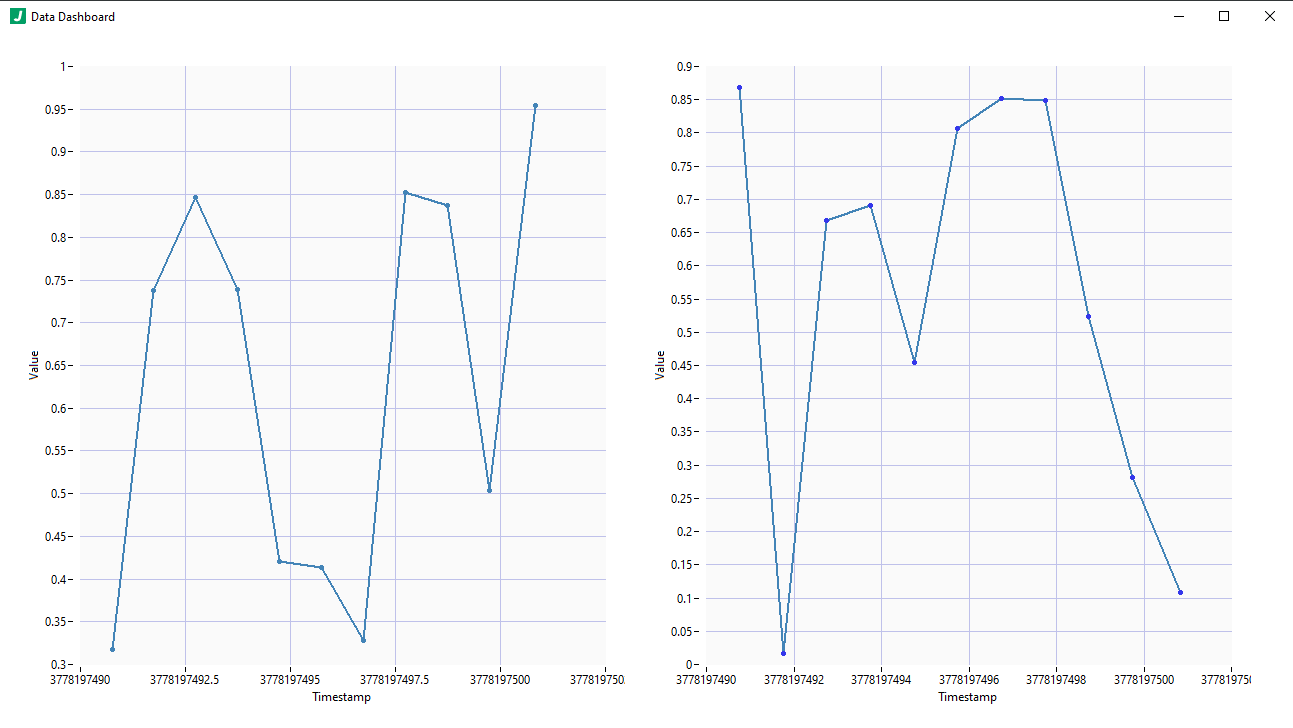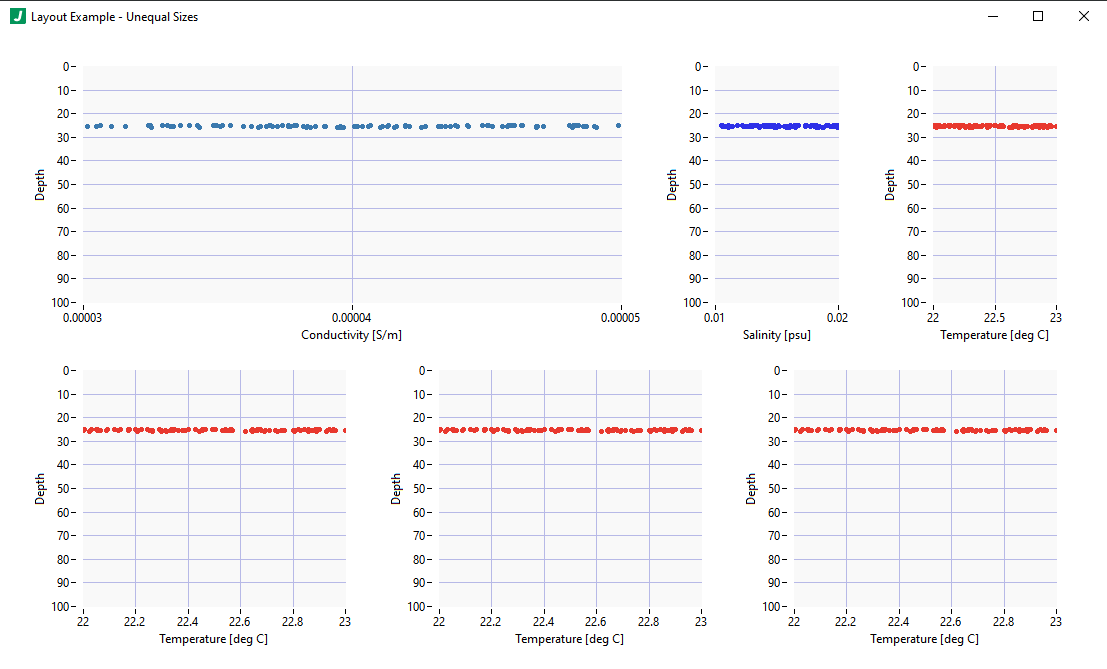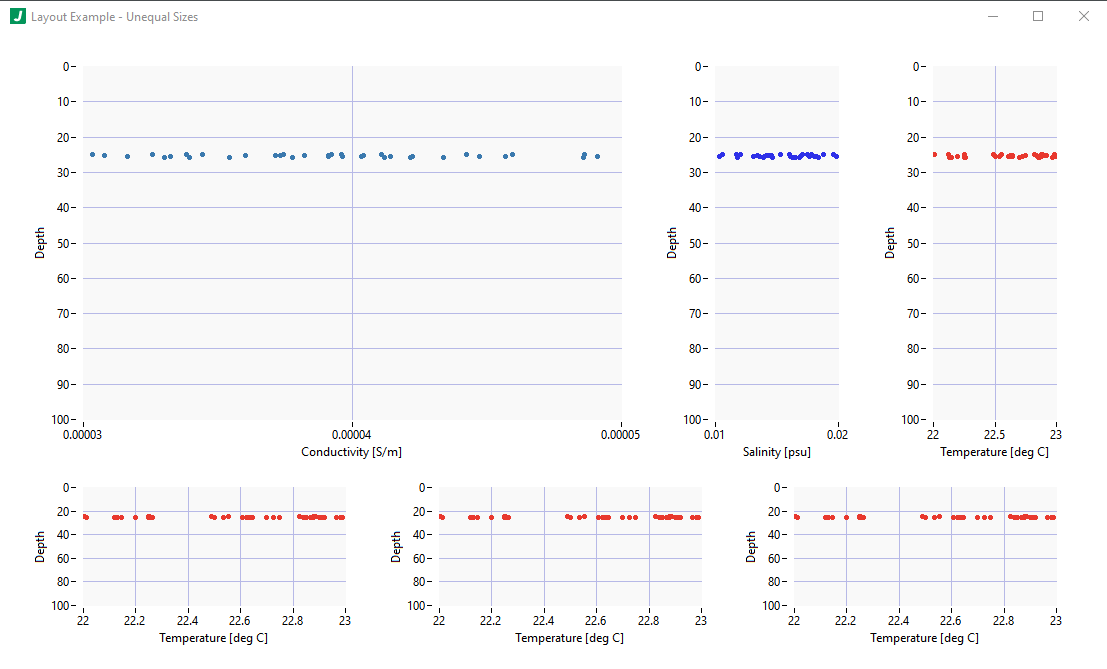ROOT object
This top level object holds all configuration information for this plugin.
Required: true
Default: (not specified; see any element defaults within)
options object
Configuration options specific to this plugin. Note that variables and expressions are generally allowed in this section.
Required: true
Default: (not specified; see any element defaults within)
options.filePath string
The path to the file to open. Leave this empty to be prompted to select a file when the plugin is run.
Required: true
Default: "C:\\data.csv"
options.delimiter string
The delimiter used to distinguish values within a given row when parsing the file. Note that line feed (\n) and carriage return (\r) characters are used to distinguish between rows.
Required: true
Default: ","
options.synchronizeChartYScales boolean
Whether to synchronize the y-scales for all charts. If true, changing any chart's y-scale at run-time will force the other charts' y-scales to match.
Required: true
Default: false
options.resizeChartsWithPanel boolean
Whether to resize charts proportionally when the panel is resized.
Required: true
Default: true
options.grid object
An object defining the grid in which the charts will lay out. The layout element (a 2D array of chart ids) defines the order in which charts are rendered. Chart sizes are specified in the individual chart definitions (see plotArea.size).
Required: true
Default: {
"outerMargins": {
"top": 20,
"bottom": 20,
"left": 20,
"right": 20
},
"innerGaps": {
"vertical": 20,
"horizontal": 20
},
"layout": [
[]
]
}
options.grid.outerMargins object
An object defining the margin to use around the outside of the grid. The panel will be fitted around the grid automatically.
Required: false
Default: (not specified; see any element defaults within)
options.grid.outerMargins.top integer
The margin above the grid.
Required: true
Default: 20
options.grid.outerMargins.bottom integer
The margin below the grid.
Required: true
Default: 20
options.grid.outerMargins.left integer
The margin to the left of the grid.
Required: true
Default: 20
options.grid.outerMargins.right integer
The margin to the right of the grid.
Required: true
Default: 20
options.grid.innerGaps object
The inner gap sizes which space the charts from one another.
Required: false
Default: (not specified; see any element defaults within)
options.grid.innerGaps.betweenRows integer
The vertical gap in pixels to add between charts.
Required: true
Default: 20
options.grid.innerGaps.betweenColumns integer
The horinzontal gap in pixels to add between charts.
Required: true
Default: 20
options.grid.layout array
A 2D array which defines the layout for the charts. Charts in a given row are layed out in order according to their sizes and the specified vertical and horizontal grid gaps. The tallest chart in a given row will bump down the row below it accordingly. Said differently, chart sizes are determined in the chart definitions (see plotArea.size within a chart's properties) and the layout array only determines the layout of those charts. The panelMargin and gridSpacing are also taken into account in the layout.
Required: false
options.grid.layout[n] array
An array of chart layout entries corresponding to a row.
Required: false
options.grid.layout[n].[n] string
A chart id (i.e. a key name in the charts configuration).
Required: false
Default: ""
options.charts object
An object where keys are chart ids and values are chart configurations which include properties (ex. label, position, axes information, etc.) and plots (an array of plot objects). Charts defined here will display on the user interface according to their properties AND the grid definition which determines the layout (see the grid property for more details). This plugin currently allows up to 20 charts. For additional charts consider using another instance of this plugin.
Required: true
options.charts.{Chart ID} object
An object definiting a chart including its properties and plots.
Required: false
Default: (not specified; see any element defaults within)
options.charts.{Chart ID}.properties object
An object definiting the chart properties.
Required: true
Default: (not specified; see any element defaults within)
options.charts.{Chart ID}.properties.label string
The label to display on the chart.
Required: true
Default: "My Plot Name"
options.charts.{Chart ID}.properties.xAxis object
The x-axis properties.
Required: true
Default: {
"label": "x-axis",
"format": "%d",
"flipped": false,
"min": 0,
"max": 10,
"increment": 1,
"autoscale": "on"
}
options.charts.{Chart ID}.properties.xAxis::{Specify Min/Max/Autoscale} object
This configuration for the x-axis requires configuring label, format, flipped, min, max, increment, and autoscale.
Required: false
Default: (not specified; see any element defaults within)
options.charts.{Chart ID}.properties.xAxis::{Specify Min/Max/Autoscale}.label string
The x-axis label to display.
Required: true
Default: "x-axis"
options.charts.{Chart ID}.properties.xAxis::{Specify Min/Max/Autoscale}.flipped boolean
Whether to flip the x-axis (ex. if true, instead of rendering 0 on the left and 10 on the right of the x-axis, it would render 0 on the right and 10 on the left.
Required: true
Default: false
options.charts.{Chart ID}.properties.xAxis::{Specify Min/Max/Autoscale}.min number
The x-axis min value.
Required: true
Default: 0
options.charts.{Chart ID}.properties.xAxis::{Specify Min/Max/Autoscale}.max number
The x-axis max value.
Required: true
Default: 10
options.charts.{Chart ID}.properties.xAxis::{Specify Min/Max/Autoscale}.increment number
The x-axis increment used to display x-axis tick marks.
Required: true
Default: 1
options.charts.{Chart ID}.properties.xAxis::{Specify Min/Max/Autoscale}.autoscale enum (string)
Whether to autoscale the x-axis. The value "on" autoscales on every update, "off" never autoscales, and "once" autoscales just once when data is first rendered.
Required: true
Default: "on"
Enum Items: "on" | "off" | "once"
options.charts.{Chart ID}.properties.xAxis::{Specify Duration} object
This configuration for the x-axis required configuring label, format, duration, and numTicks.
Required: false
Default: (not specified; see any element defaults within)
options.charts.{Chart ID}.properties.xAxis::{Specify Duration}.label string
The x-axis label to display.
Required: true
Default: "x-axis"
options.charts.{Chart ID}.properties.xAxis::{Specify Duration}.duration number
The time duration in seconds to display on the x-axis.
Required: true
Default: 0
options.charts.{Chart ID}.properties.xAxis::{Specify Duration}.numTicks number
The number of ticks to show on the x-axis.
Required: true
Default: 0
options.charts.{Chart ID}.properties.yAxis object
The y-axis properties.
Required: true
Default: (not specified; see any element defaults within)
options.charts.{Chart ID}.properties.yAxis.label string
The y-axis label to display.
Required: true
Default: "y-axis"
options.charts.{Chart ID}.properties.yAxis.flipped boolean
Whether to flip the y-axis (ex. if true, instead of rendering 0 on the bottom and 10 on the top of the y-axis, it would render 0 on the top and 10 on the bottom.
Required: true
Default: false
options.charts.{Chart ID}.properties.yAxis.min number
The y-axis min value.
Required: true
Default: 0
options.charts.{Chart ID}.properties.yAxis.max number
The y-axis max value.
Required: true
Default: 10
options.charts.{Chart ID}.properties.yAxis.increment number
The y-axis increment used to display y-axis tick marks.
Required: true
Default: 1
options.charts.{Chart ID}.properties.yAxis.autoscale enum (string)
Whether to autoscale the y-axis. The value "on" autoscales on every update, "off" never autoscales, and "once" autoscales just once when data is first rendered.
Required: true
Default: "on"
Enum Items: "on" | "off" | "once"
options.charts.{Chart ID}.properties.plotArea object
The plot area properties.
Required: false
Default: (not specified; see any element defaults within)
options.charts.{Chart ID}.properties.plotArea.fgColor object
The plot area foreground color specified as an RGB value.
Required: true
Default: (not specified; see any element defaults within)
options.charts.{Chart ID}.properties.plotArea.fgColor.r integer
The red component of the RGB color definition.
Required: true
Default: 255
options.charts.{Chart ID}.properties.plotArea.fgColor.g integer
The green component of the RGB color definition.
Required: true
Default: 255
options.charts.{Chart ID}.properties.plotArea.fgColor.b integer
The blue component of the RGB color definition.
Required: true
Default: 255
options.charts.{Chart ID}.properties.plotArea.bgColor object
The plot area background color specified as an RGB value.
Required: true
Default: (not specified; see any element defaults within)
options.charts.{Chart ID}.properties.plotArea.bgColor.r integer
The red component of the RGB color definition.
Required: true
Default: 250
options.charts.{Chart ID}.properties.plotArea.bgColor.g integer
The green component of the RGB color definition.
Required: true
Default: 250
options.charts.{Chart ID}.properties.plotArea.bgColor.b integer
The blue component of the RGB color definition.
Required: true
Default: 250
options.charts.{Chart ID}.plots array
An array of plot objects which define plot properties and data.
Required: true
options.charts.{Chart ID}.plots[n] object
An object defining a plot.
Required: false
Default: (not specified; see any element defaults within)
options.charts.{Chart ID}.plots[n].name string
The name of the plot.
Required: true
Default: "My Plot"
options.charts.{Chart ID}.plots[n].historyLength integer
The number of data points to store and render for this plot.
Required: true
Default: 100
options.charts.{Chart ID}.plots[n].data object
An object defining x and y values which make up a point in this plot on the chart. VAR namespace variables are available when defining x and y.
Required: true
Default: (not specified; see any element defaults within)
options.charts.{Chart ID}.plots[n].data.x stringnumber
The value of the x-coordinate to compute at the samplePeriod. VAR namespace variables are available here.
Required: true
Default: 0
options.charts.{Chart ID}.plots[n].data.y stringnumber
The value of the y-coordinate to compute at the samplePeriod. VAR namespace variables are available here.
Required: true
Default: 0
options.charts.{Chart ID}.plots[n].annotation object
An object defining how to annotate the most recent data point in the plot. Annotations consist of several parts, some of which are optional: point, point decoration, and the annotation value (which is the most recent plot value).
Required: true
Default: (not specified; see any element defaults within)
options.charts.{Chart ID}.plots[n].annotation.enable boolean
Whether to render an annotation on the most recent data point in the plot.
Required: true
Default: false
options.charts.{Chart ID}.plots[n].annotation.showLabel boolean
Whether to also display the x and y values of the annotated point.
Required: true
Default: true
options.charts.{Chart ID}.plots[n].annotation.showArrow boolean
Whether to draw an arrow from the label to the corresponding (most recent plotted) data point.
Required: true
Default: false
options.charts.{Chart ID}.plots[n].annotation.color object
The color to use for plot points specified as an RGB value.
Required: true
Default: (not specified; see any element defaults within)
options.charts.{Chart ID}.plots[n].annotation.color.r integer
The red component of the RGB color definition.
Required: true
Default: 100
options.charts.{Chart ID}.plots[n].annotation.color.g integer
The green component of the RGB color definition.
Required: true
Default: 100
options.charts.{Chart ID}.plots[n].annotation.color.b integer
The blue component of the RGB color definition.
Required: true
Default: 100
options.charts.{Chart ID}.plots[n].annotation.pointStyle enum (string)
The annotation point style such as a circle vs a square.
Required: true
Default: "circleFull"
Enum Items: "none" | "circleEmpty" | "circleFull" | "circleFullDot" | "circleEmptyDot" | "squareEmpty" | "squareFull" | "squareFullDot" | "squareEmptyDot" | "squareFullSmall" | "dot" | "cross" | "crossSmall" | "X" | "x" | "diamondFullDot" | "squareEmptySmall"
options.charts.{Chart ID}.plots[n].annotation.pointDecoration enum (string)
The decoration to use on the anntation point, such as putting crosshair-like dashes on the annotation point.
Required: true
Default: "dashBoth"
Enum Items: "none" | "dashVertical" | "dashHorizontal" | "dashBoth" | "lineVertical" | "lineHorizontal" | "lineBoth" | "dashVerticalLineHorizontal" | "dashHorizontalLineVertical"
options.charts.{Chart ID}.plots[n].annotation.label object
An object defining how to render the annotation label.
Required: true
Default: (not specified; see any element defaults within)
options.charts.{Chart ID}.plots[n].annotation.label.anchorPosition enum (string)
The anchor position of the label. The padding will apply relative to this selected anchor position.
Required: true
Default: "Point"
Enum Items: "Point" | "TopLeft" | "TopCenter" | "TopRight" | "BottomLeft" | "BottomCenter" | "BottomRight" | "MiddleLeft" | "MiddleRight"
options.charts.{Chart ID}.plots[n].annotation.label.padding object
An object defining x and y padding in pixels, relative to the anchorPosition, at which to render the annotation label. Positive means move inward on the graph from the anchor position.
Required: true
Default: (not specified; see any element defaults within)
options.charts.{Chart ID}.plots[n].annotation.label.padding.x integer
The x-padding in pixels relative to the anchor position.
Required: true
Default: 0
options.charts.{Chart ID}.plots[n].annotation.label.padding.y integer
The y-padding in pixels relative to the anchor position.
Required: true
Default: 20
options.charts.{Chart ID}.plots[n].properties object
An object defining the plot properties.
Required: true
Default: (not specified; see any element defaults within)
options.charts.{Chart ID}.plots[n].properties.visible boolean
Whether the plot is visible in the chart.
Required: true
Default: true
options.charts.{Chart ID}.plots[n].properties.antiAlias boolean
Whether the apply antiAliasing when rendering the plot.
Required: true
Default: true
options.charts.{Chart ID}.plots[n].properties.pointStyle enum (string)
The point style to use for the plot.
Required: true
Default: "circleFull"
Enum Items: "none" | "circleEmpty" | "circleFull" | "circleFullDot" | "circleEmptyDot" | "squareEmpty" | "squareFull" | "squareFullDot" | "squareEmptyDot" | "squareFullSmall" | "dot" | "cross" | "crossSmall" | "X" | "x" | "diamondFullDot" | "squareEmptySmall"
options.charts.{Chart ID}.plots[n].properties.lineStyle enum (string)
The line style to use for the plot.
Required: true
Default: "solid"
Enum Items: "solid" | "dash" | "dot" | "dashdot" | "dashdotdot"
options.charts.{Chart ID}.plots[n].properties.lineWidth enum (string)
The line width to use for the plot.
Required: true
Default: "1"
Enum Items: "0" | "1" | "2" | "3" | "4" | "5"
options.charts.{Chart ID}.plots[n].properties.fillTo enum (string)
The color fill approach to use for the plot. For example, "below" would apply the line color to the area below the plot in the chart.
Required: true
Default: "none"
Enum Items: "none" | "zero" | "below" | "above"
options.charts.{Chart ID}.plots[n].properties.interpolation enum (string)
The interpolation strategy to apply between points.
Required: true
Default: "none"
Enum Items: "none" | "stepwiseVertical" | "linear" | "stepwiseHorizontal" | "stepwiseHorizontalCentered" | "stepwiseVerticalCentered"
options.charts.{Chart ID}.plots[n].properties.lineColor objectstring
The color to use for the plot line specified as an RGB value.
Required: true
Default: "auto"
options.charts.{Chart ID}.plots[n].properties.pointColor objectstring
The color to use for plot points specified as an RGB value.
Required: true
Default: "auto"
options.logger object
Defines the logging (data and errors) for this plugin. Note that a LOG variable space is provided here, as well as the VAR variable space. Available variables are: @LOG{LOGGERNAME}, @LOG{TIMESTAMP}, @LOG{LOGMESSAGE}, @LOG{ERRORMESSAGE}, and @VAR{instanceName} are available variables. note: @LOG{LOGGERNAME} is equal to the @VAR{instanceName} here.
Required: true
Default: (not specified; see any element defaults within)
options.logger.Enable boolean
Whether to enable the logger.
Required: true
Default: true
options.logger.LogFolder string
The folder in which to write log files.
Required: true
Default: "\\JADE_LOGS\\@VAR{instanceName}"
options.logger.ErrorsOnly boolean
Whether to log only errors.
Required: true
Default: true
options.logger.DiskThrashPeriod integer
The period in milliseconds with which to flush the file buffer to ensure it's committed to the hard drive. Note: This is a performance consideration to prevent writing to disk too frequently.
Required: true
Default: 1000
options.logger.FileSizeLimit integer
The file size at which to create new files.
Required: true
Default: 1000000
options.logger.LogEntryFormat string
The format to use when writing log entries when errors are not present.
Required: true
Default: "\n\n@LOG{LOGMESSAGE}"
options.logger.ErrorLogEntryFormat string
The message format used to construct error log entries.
Required: true
Default: "\n\n@LOG{ERRORMESSAGE}"
panel object
Required: true
Default: (not specified; see any element defaults within)
panel.open boolean
Whether to open the front panel immediately when run.
Required: true
Default: true
panel.state enum (string)
The state in which the window will open.
Required: true
Default: "Standard"
Enum Items: "Standard" | "Hidden" | "Closed" | "Minimized" | "Maximized"
panel.transparency integer
The transparency of the window. 0 = opaque, 100 = invisible.
Required: true
Default: 0
panel.title string
The title of the plugin window when it runs. Note that the variable 'instanceName' is provided here in a VAR variable container.
Required: true
Default: "@VAR{instanceName}"
panel.titleBarVisible boolean
Whether the window title bar is visible.
Required: true
Default: true
panel.makeActive boolean
Whether the window becomes active when opened.
Required: true
Default: false
panel.bringToFront boolean
Whether the window is brought to the front / top of other windows when opened.
Required: true
Default: false
panel.minimizable boolean
Whether the window is minimizable.
Required: true
Default: true
panel.resizable boolean
Whether the window is resizable.
Required: true
Default: true
panel.closeable boolean
Whether the window is closeable.
Required: true
Default: true
panel.closeWhenDone boolean
Whether to close the window when complete.
Required: true
Default: true
panel.center boolean
Whether to center the window when opened. Note: this property overrides the 'position' property.
Required: true
Default: false
panel.position object
The position of the window when opened the first time.
Required: true
Default: (not specified; see any element defaults within)
panel.position.top integer
The vertical position of the window in pixels from the top edge of the viewport. Note: this property is overriden by the 'center' property.
Required: true
Default: 100
panel.position.left integer
The horizontal position of the window in pixels from the left edge of the viewport. Note: this property is overriden by the 'center' property.
Required: true
Default: 100
panel.size object
The size of the window when opened the first time.
Required: false
Default: (not specified; see any element defaults within)
panel.size.width integer
The width of the window in pixels. -1 means use the default width for the panel. Note that depending on panel features exposed, there may be a limit to how small a panel can become.
Required: true
Default: -1
panel.size.height integer
The height of the window in pixels. -1 means use the default height for the panel. Note that depending on panel features exposed, there may be a limit to how small a panel can become.
Required: true
Default: -1
channel object
The communication channel definition used by this plugin. Note: this section rarely needs modifications. In many cases, the underlying plugin implementation depends on at least some of these settings having the values below. Consult with a JADE expert before making changes to this section if you are unfamiliar with the implications of changes to this section.
Required: true
Default: (not specified; see any element defaults within)
channel.SendBreakTimeout integer
The timeout duration in milliseconds to wait for sending messages.
Required: true
Default: 1000
channel.WaitOnBreakTimeout integer
The timeout duration in milliseconds to wait for receiving messages. Note: -1 means wait indefinitely or until shutdown is signalled.
Required: true
Default: -1
channel.WaitOnShutdownTimeout integer
The timeout duration in milliseconds to wait for shutdown acknowledgment.
Required: true
Default: 2000
channel.ThrowTimeoutErrors boolean
Whether to throw timeout errors vs simply returning a boolean indicating whether a timeout occurred.
Required: true
Default: false
channel.ThrowShutdownUnacknowledgedErrors boolean
Whether to throw 'shutdown unacknowledged' errors.
Required: true
Default: true
channel.QueueSize integer
The size of the underlying communication queue in bytes. Note: -1 means unbounded (i.e. grow as needed with available memory).
Required: true
Default: -1
channel.SendBreakEnqueueType enum (string)
The enqueue strategy employed on the underlying queue for standard messages.
Required: true
Default: "Enqueue"
Enum Items: "Enqueue" | "EnqueueAtFront" | "LossyEnqueue" | "LossyEnqueueAtFront"
channel.SendErrorEnqueueType enum (string)
The enqueue strategy employed on the underlying queue for error messages.
Required: true
Default: "Enqueue"
Enum Items: "Enqueue" | "EnqueueAtFront" | "LossyEnqueue" | "LossyEnqueueAtFront"
channel.SendShutdownEnqueueType enum (string)
The enqueue strategy employed on the underlying queue for the shutdown message.
Required: true
Default: "LossyEnqueueAtFront"
Enum Items: "Enqueue" | "EnqueueAtFront" | "LossyEnqueue" | "LossyEnqueueAtFront"
channel.FlushQueueBeforeWaitingOnBreak boolean
Whether to flush the queue upon waiting for new messages (i.e. whether to clear the queue and wait for the next 'new' message; this has the effect of removing old messages and waiting for the next message.
Required: true
Default: false
channel.FlushQueueAfterBreaking boolean
Whether to flush the queue after receiving a new message (i.e. whether to handle the next message coming in the queue and then flush; this has the effect of handling the oldest message (if it exsits) or the next message before flushing the queue.
Required: true
Default: false


